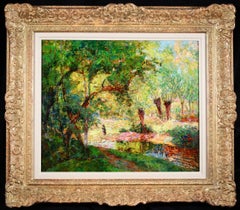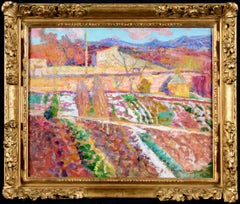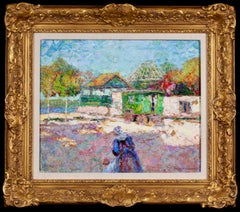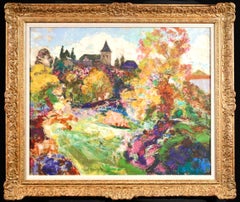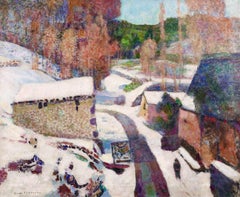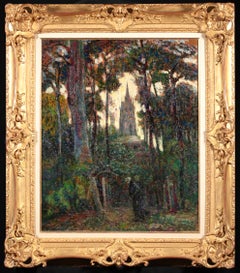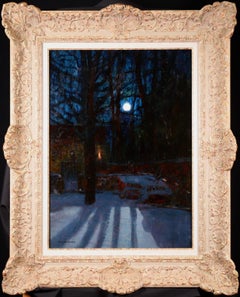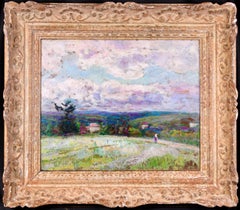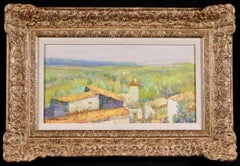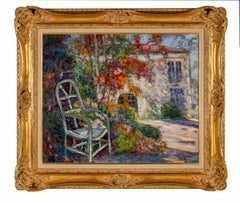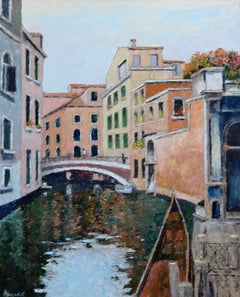Charreton Victor
1910s Post-Impressionist Landscape Paintings
Oil, Board
1910s Post-Impressionist Landscape Paintings
Board, Oil
1920s Post-Impressionist Figurative Paintings
Oil, Board
1910s Post-Impressionist Landscape Paintings
Canvas, Oil
1910s Post-Impressionist Landscape Paintings
Oil, Canvas
1910s Post-Impressionist Landscape Paintings
Oil, Board
1920s Post-Impressionist Landscape Paintings
Oil, Board
1920s Post-Impressionist Landscape Paintings
Oil, Board
1920s Post-Impressionist Landscape Paintings
Oil, Board
1930s Post-Impressionist Landscape Paintings
Oil, Panel
1920s Post-Impressionist Landscape Paintings
Oil, Canvas
20th Century Impressionist Landscape Paintings
Canvas, Oil
Recent Sales
Early 20th Century Impressionist Paintings
Canvas, Oil
20th Century Impressionist Landscape Paintings
Canvas, Oil
20th Century Impressionist Landscape Paintings
Canvas, Oil
21st Century and Contemporary Impressionist Landscape Paintings
Canvas, Oil
21st Century and Contemporary Impressionist Landscape Paintings
Canvas, Oil
20th Century Post-Impressionist Landscape Paintings
Canvas, Oil
Early 1900s Landscape Paintings
Oil, Canvas
1920s Post-Impressionist Landscape Paintings
Oil, Board
1920s Post-Impressionist Landscape Paintings
Oil, Canvas
1920s Post-Impressionist Figurative Paintings
Oil, Board
1910s Post-Impressionist Landscape Paintings
Oil, Board
1920s Post-Impressionist Figurative Paintings
Oil, Board
Early 20th Century Post-Impressionist Landscape Paintings
Board, Oil
1920s Post-Impressionist Landscape Paintings
Oil, Board
Early 19th Century Impressionist Figurative Paintings
Oil, Panel
Early 1900s Post-Impressionist Still-life Paintings
Oil, Canvas
Early 19th Century Impressionist Landscape Paintings
Oil, Board
1910s Post-Impressionist Figurative Paintings
Oil, Board
Late 19th Century Impressionist Landscape Paintings
Oil, Board
Early 20th Century Impressionist Still-life Paintings
Canvas, Oil
Early 20th Century Impressionist Landscape Paintings
Oil, Board
Early 20th Century Impressionist Landscape Paintings
Canvas, Oil
20th Century Post-Impressionist Landscape Paintings
Canvas, Oil
Early 20th Century Impressionist Landscape Paintings
Oil, Board
1910s Post-Impressionist Landscape Paintings
Oil, Board
1910s Post-Impressionist Figurative Paintings
Oil, Board
Early 20th Century Impressionist Landscape Paintings
Oil, Panel
Early 20th Century Impressionist Landscape Paintings
Oil, Panel, Paper
Early 20th Century Impressionist Landscape Paintings
Canvas, Oil
Early 20th Century Impressionist Landscape Paintings
Canvas, Oil
Early 20th Century Post-Impressionist Landscape Paintings
Oil, Panel
Early 20th Century Post-Impressionist Landscape Paintings
Oil, Board
Early 1900s Impressionist Landscape Paintings
Board, Oil
Early 1900s Impressionist Figurative Paintings
Oil
Mid-20th Century Post-Impressionist Still-life Paintings
Canvas, Oil
19th Century Impressionist Landscape Paintings
Canvas, Oil
20th Century Impressionist Still-life Paintings
Canvas, Oil
People Also Browsed
1940s Post-Impressionist Landscape Paintings
Canvas, Oil
2010s Impressionist Landscape Paintings
Oil, Board
Early 1900s Impressionist Landscape Paintings
Oil, Panel
1730s Old Masters Animal Paintings
Oil
Early 1900s Impressionist Figurative Paintings
Canvas, Oil
Antique Late 18th Century German Baroque Porcelain
Meissen
Early 19th Century Romantic Interior Paintings
Canvas, Oil
21st Century and Contemporary American Impressionist Landscape Paintings
Oil, Board
Thomas deDecker"Artist's Studio - Pond" Colorful Impressionist Landscape Oil Painting on Board, 2024
20th Century Post-Impressionist Landscape Paintings
Canvas, Oil
1920s Impressionist Landscape Paintings
Canvas, Oil
Mid-19th Century Hudson River School Landscape Paintings
Paper, Oil, Board
Early 20th Century Impressionist Landscape Paintings
Canvas, Oil
20th Century American Impressionist Landscape Paintings
Oil, Canvas
Vintage 1910s Belgian Belle Époque Paintings
Paint
Antique 18th Century German Rococo Wine Coolers
Tin
1940s Impressionist Landscape Paintings
Oil
Charreton Victor For Sale on 1stDibs
How Much is a Charreton Victor?
Victor Charreton for sale on 1stDibs
Victor Charreton was the son of a surveyor. He spent his childhood in Chaumont and went to school in Bourgoin. In 1885 he began studying law at Grenoble University and in 1892 became a solicitor at the Lyons Court of Appeal. He had been creating paintings since childhood and was given advice by Ernest Hareux (he did not merely read his treatise on painting, which was highly regarded at the time) and also later by Louis Japy.
In 1902 Charreton gave up his legal career to devote his time to painting. The same year he moved to Paris. Every summer, from 1912 onwards, he would spend time at his house in St-Amant-Tallende near Clermont-Ferrand, where his wife came from. He also traveled abroad — to Algeria in 1905, to Spain and England in 1912 and to Belgium and Holland in 1913 — visiting numerous museums along the way. He also visited Corsica and Germany. He led the life of an aesthete and man of culture and was a lover of poetry and music. In 1914 he was made a Chevalier of the Légion d'Honneur.
Charreton was a landscape artist in the Lyons tradition with a love of sensual impasto. In his works he sought to capture fleeting, momentary effects, like those achieved by the Impressionists: effects at different times of day and in different seasons, such as dusk and snow. As a young man he painted the environs of Bourgoin, but his marriage in 1893 took him to Auvergne where he painted the characteristic landscapes of the region. Landscapes of Auvergne make up approximately two-thirds of Charreton’s output. What became known as the School of Murols, named after a village in Auvergne, was principally formed around him between 1910 and 1925. Skilled in capturing minute changes in the weather, he was also adept at capturing the spirit of new places.
Beside his native Dauphiné and his adopted Auvergne, Charreton was also charmed by the landscapes of the Île-de-France and Paris — Montmartre, the Jardin du Luxembourg and the Parc Montsouris — and also Provence, Creuse and Brittany. However, no trace has been found of his trips abroad. It would be a misjudgment to think that Charreton only painted pretty picture-postcard scenes in the regions he visited; on the contrary, he would seek out the intimist qualities of a place, choosing perhaps a quiet hamlet, with a humble bridge over an anonymous stretch of water, or an ordinary tree outside a tumbledown house.
Charreton would paint blazing autumn landscapes, with a sumptuous color palette, but also favored snowy scenes, their exact chromatic opposite. At the start of his career he would paint dusky scenes and contre-jours in halftones and misty sunsets. As Charreton’s artistic development progressed, he attached more and more importance to light and color. In this respect his work follows on from that of Ravier and, like Guillaumin, it is almost a precursor to Fauvism, or alternatively can be regarded as complicit with it, like the work of Maurice Marinot. Charreton’s brushwork evolved in tandem with his use of color, which became ever more vibrant; for example his fondness for purple hues and later his striking color contrasts. His brushwork became more conspicuous and he would suppress the insignificant details in order to bring out the forms that made up the general composition.
Among art historians Charreton is not ranked alongside the innovators who succeeded the Impressionists, like Gauguin, Seurat, Van Gogh or Cézanne. Older than Matisse, who was himself already by far the eldest of the Fauves, Charreton stopped short of what he considered to be their excesses. He placed himself at the crossroads between two centuries: the end of the century of Impressionism and the start of the leaps made by Fauvism. His life and the major themes in his work are evidence of this, but he decided to be a regional painter; as such, his talent and qualities are clearer than they may otherwise have been if he had chosen a more ambitious career. Beside his painting, he also wrote a play in three acts entitled The Montrouge Well (Le Puits de Montrouge), which was performed in Bourgoin in December 1883.
Charreton made his debut at the Lyons Salon in 1894 with Morning in Montpeyroux. That same year he began exhibiting in Paris at the Salon of the Société des Artistes Français, showing October Evening. He was awarded an honorable mention in 1910, a silver medal in 1912, a gold medal in 1913 and a commendation outside the competition in 1914. He also became a member of the committee and the jury and exhibited there until his death.
Charreton took part in collective exhibitions in France — in Toulouse, Clermont-Ferrand, Roubaix and Bordeaux — and abroad, in New York, Geneva and Barcelona. In 1915 he held a solo exhibition at the Galerie Georges Petit in Paris. He exhibited in New York, Toledo, Pittsburgh, Cleveland and Japan. In 1931 Charreton inaugurated the Musée de Bourgoin by donating around 20 works; the museum then changed its name to the Musée Victor Charreton. He was also one of the founders and general secretary of the Salon d'Automne. In 1972 the Musée de Montmartre organized a posthumous retrospective exhibition of his work; in 1987 and 1989 two more were held in a Paris gallery; then in 2003 the Musée de Bourgoin-Jallieu (in Isère) held in exhibition entitled “Victor Charreton: The Public Collections.”
Find original Victor Charreton art on 1stDibs.
(Biography provided by Leighton Fine Art)
Finding the Right Landscape-paintings for You
It could be argued that cave walls were the canvases for the world’s first landscape paintings, which depict and elevate natural scenery through art, but there is a richer history to consider.
The Netherlands was home to landscapes as a major theme in painting as early as the 1500s, and ink-on-silk paintings in China featured mountains and large bodies of water as far back as the third century. Greeks created vast wall paintings that depicted landscapes and grandiose garden scenes, while in the late 15th century and early 16th century, landscapes were increasingly the subject of watercolor works by the likes of Leonardo da Vinci and Fra Bartolomeo.
The popularity of religious paintings eventually declined altogether, and by the early 19th century, painters of classical landscapes took to painting out-of-doors (plein-air painting). Paintings of natural scenery were increasingly realistic but romanticized too. Into the 20th century, landscapes remained a major theme for many artists, and while the term “landscape painting” may call to mind images of lush, grassy fields and open seascapes, the genre is characterized by more variety, colors and diverse styles than you may think. Painters working in the photorealist style of landscape painting, for example, seek to create works so lifelike that you may confuse their paint for camera pixels. But if you’re shopping for art to outfit an important room, the work needs to be something with a bit of gravitas (and the right frame is important, too).
Adding a landscape painting to your home can introduce peace and serenity within the confines of your own space. (Some may think of it as an aspirational window of sorts rather than a canvas.) Abstract landscape paintings by the likes of Korean painter Seungyoon Choi or Georgia-based artist Katherine Sandoz, on the other hand, bring pops of color and movement into a room. These landscapes refuse to serve as a background. Elsewhere, Adam Straus’s technology-inspired paintings highlight how our extreme involvement with our devices has removed us from the glory of the world around us. Influenced by modern life and steeped in social commentary, Straus’s landscape paintings make us see our surroundings anew.
Whether you’re seeking works by the world’s most notable names or those authored by underground legends, find a vast collection of landscape paintings on 1stDibs.
